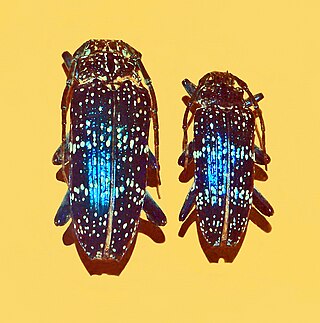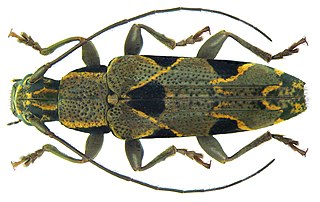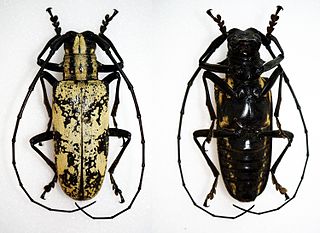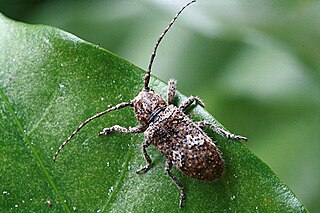
Sphingnotus insignis is a species of beetle belonging to the family Cerambycidae.

Sphingnotus mirabilis is a species of beetle belonging to the family Cerambycidae.
Periboeum is a genus of beetles in the family Cerambycidae, containing the following species:
Stizocera elegantula is a species of beetle in the family Cerambycidae. It was described by Perroud in 1855.
Amphicnaeia albovittata is a species of beetle in the family Cerambycidae. It was described by Stephan von Breuning in 1971.

Tmesisternini is a tribe of beetles in the subfamily Lamiinae containing the following genera:

Homonoeini is a tribe of longhorn beetles of the subfamily Lamiinae. It was described by James Thomson in 1864.

Paraepepeotes is a genus of longhorn beetles of the subfamily Lamiinae, containing the following species:
Potemnemus kaszabi is a species of beetle in the family Cerambycidae. It was described by Stephan von Breuning in 1973.
Eudaphisia is a genus of longhorn beetles found in Asia. It was first identified by Pic in 1926 with the two species, Eudaphisia longicornis and Eudaphisia albonotata, the type species. In 1968, the species Eudaphisia albonotatipennis was identified by Breuning. Individuals have been identified in both Laos and Vietnam. In 1991, Eudaphisia longicornis was recorded in China, but was actually an incorrectly identified Neoserixia sp.

Trigonoptera is a genus of longhorn beetles of the subfamily Lamiinae, containing the following species:
Eunidia unifuscomaculata is a species of beetle in the family Cerambycidae. It was first described by Stephan von Breuning in 1960. Its name is derived from Latin, meaning "[having] only one brown stain."
Paraepepeotes affinis is a species of beetle in the family Cerambycidae. It was described by Stephan von Breuning in 1938. It is known from India.

Paraepepeotes gigas is a species of beetle in the family Cerambycidae. It was described by Per Olof Christopher Aurivillius in 1897. It is known from Borneo and Malaysia.
Paraepepeotes isabellinoides is a species of beetle in the family Cerambycidae. It was described by Stephan von Breuning in 1960.
Paraepepeotes szetschuanicus is a species of beetle in the family Cerambycidae. It was described by Stephan von Breuning in 1969. It is known from China.
Paraepepeotes websteri is a species of beetle in the family Cerambycidae. It was described by Karl Jordan in 1898.

Paraepepeotes westwoodii is a species of beetle in the family Cerambycidae. It was described by John O. Westwood in 1848, originally under the genus Hammaticherus. It is known from India.

Rhytiphora bankii is a species of beetle in the family Cerambycidae. It was first described by Johan Christian Fabricius in 1775, under the genus Lamia. It is known from Australia, the Philippines, Borneo, Java, Micronesia, New Guinea, Hawaii, Moluccas, Sumatra, Vietnam, and has been introduced into Japan. The Australian species of Prosoplus were synonymised with Rhytiphora in 2013.

Pterolophia pilosipennis is a species of beetle in the family Cerambycidae. It was described by Stephan von Breuning in 1943. Pterolophia pilosipennis is 8.5 millimeters (0.3 in) in length.










